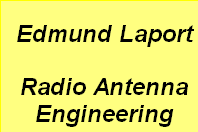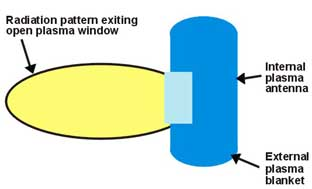

Antentop is FREE e-magazine devoted to Antennas and Amateur Radio an
Special page devoted to
Plasma Antenna Technology

Custom Search
|
ANTENTOP-
03- 2003, # 004 |
Plasma Antenna Technology
|
|
|
|
|
A second fundamental distinguishing feature is that
after sending a pulse the plasma antenna can be deionized, eliminating
the ringing associated with traditional metal elements. Ringing
and the associated noise of a metal antenna can severely limit
capabilities in high frequency short pulse transmissions. In these
applications, metal antennas are often accompanied by sophisticated
computer signal processing. By reducing ringing and noise, we
believe our plasma antenna provides increased accuracy and reduces
computer signal processing requirements. These advantages are
important in cutting edge applications for impulse radar and high-speed
digital communications. Based on the results of development to date, plasma
antenna technology has the following additional attributes: No antenna ringing provides an improved signal to noise
ratio and reduces multipath signal distortion. -A single dynamic antenna structure can use time multiplexing
so that many RF subsystems can share one antenna resource reducing
the number and size of antenna structures. Sponsored
Work |
-ONR contract N66001-97-M-1153 May 1997
- The major objective of this program was to determine the noise
levels associated with the use of gas plasma as a conductor for
a transmitting and receiving antenna. Both laboratory and field-test
measurements were conducted. -ONR contract N00014-98-C-0045 November
1997 - The major objective of this effort was to characterize
the GP antenna for conductivity, ionization breakdowns, upper
frequency limits, excitation and relaxation times, ignition mechanisms,
temperatures and thermionic noise emissions and compare these
results to a reference folded copper wire monopole. The measured
radiation patterns of the plasma antenna compared very well with
copper wire antennas. -MDA Phase I SBIR Contract DASG60-01-P-0063
May 2001 - This six month work (expanded for an additional three
months by MDA) focused on using plasma rather than solid metal
as the current medium for an antenna. We illustrated the use of
controllable apertures (open plasma windows) for far field antenna
radiation. Experiments verified our plasma windowing concept. -MDA Phase II SBIR Contract DASG60-02-C-0055 April
2002 - This 24 month contract is focusing on developing a feasibility
prototype high power antenna based on our windowing concept and
to design and develop a high power phased array using plasma phase
shifters to steer the beam. Malibu Research Associates is our
subcontractor on this project. -MDA Phase I SBIR Contract DASG60-02-P-0033
April 2002 - This 6 month contract focused on using plasma as
a replacement for metal in a frequency selective surface (FSS)
used to filter electromagnetic waves. A tunable FSS can absorb
frequencies above the resonant frequency and reflect those above
to reduce radar vulnerability to countermeasures. Plasma is an
excellent shield and filter for antenna systems. |
|
|
|
|
Page 27 |
|
 |
 |
 |
 |
Just for Fun:

Powered byIP2Location.com
Thanks for your time!
Last Updated:
February 26, 2020 21:38





